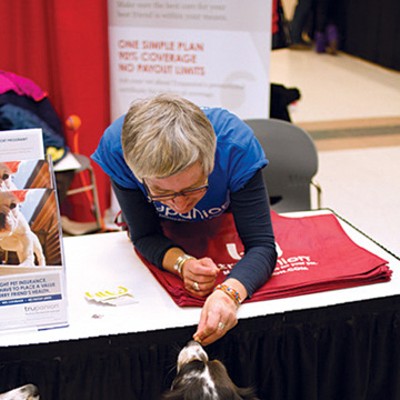
On Christmas Eve, the Midwest City woman suffered a major stroke that affected much of her left side and made the simple act of standing a grueling ordeal. But today, Price had reason to stand: a 3-year-old German Shepherd named Zephyr was on point, amber eyes glittering, ears at attention, waiting for her temporary playmate to throw a ball.
Leaning on a physical therapist at Oklahoma City’s Integris Jim Thorpe Rehabilitation, Price made the first toss, then another. Zephyr skittered across the linoleum floor to retrieve the ball and waited for the game to continue.
By the time Price returned to her wheelchair, she had stood three times longer than any previous day without realizing what she had done.
Zephyr’s owner and trainer, Carol Collins, chalked up another win for the Human Animal Link of Oklahoma, or HALO.
Established in 2001, HALO provides human-animal outreach and therapy in more than 60 locations across Central Oklahoma. The all-volunteer organization pairs 70 dog- and horse-owners and their trained, certified pets with schools, nursing homes, hospitals, hospices, libraries and the Military Welcome Center at Will Rogers World Airport.
“This field covers a gamut. It’s advocacy for people in every stage of life, going through every type of situation that human beings can possibly go through,” said Terri Smith, HALO’s founder and executive director.
A special-education teacher for 35 years, she had sought out and gained certification for her dog, Shana, as a way to reach children with behavioral and learning issues. HALO grew from their experiences.
“I
became convinced quickly that Shana was my greatest tool,” Smith said.
“We hear too many words. Human beings are not quiet enough. They’re too
quick to react and respond. When you have the right dog and the right
set of circumstances, the right volunteer, then you have a valuable
resource for individuals going through trauma or change.”
Tiny miracles
As HALO grew, Smith
developed guidelines, curricula and exercises to nudge clients toward
goals. Therapy sessions in schools are designed to help children gain
control of their actions and relationships. Library literacy programs
give kids a nonjudgmental listening ear. Adult programs offer those in
nursing homes, hospitals and veterans’ centers a pleasant way to work
through physical and speech recovery, or simply a moment to forget their
pain.
Smith said she has seen countless times how animal-assisted therapy can work tiny miracles.
One
such miracle involved an 8-year-old girl with selective mutism, a
disorder in which otherwise intelligent people choose not to speak.
Smith’s student had not spoken for seven years when she began working
with Shana.
Smith taught the child verbal commands for the dog over three weeks, then stepped away.
Smith told the girl she would have to speak for the dog to get familiar with her voice.
“I
didn’t talk for 30 minutes before I heard the first word, and it was,
‘Wha?’” recalled Smith. “I said, ‘Are you asking me what to do?’ And she
nodded.”
Soon, the
girl was speaking full words and commanding Shana. By the time their
therapy work ended two years later, the child had established
friendships and was participating in school band.
When
Smith’s work with HALO was recognized with the Ed Birchall Humanitarian
Award, the girl stood at a podium and spoke to the audience.
“I
thank God for Shana,” Smith said. “I see what she’s done for hundreds
of people in the 12 years that she has been working, and I am amazed.”
Animal instincts
Zephyr’s trainer
and the staff at Jim Thorpe are routinely amazed. On a typical
three-hour visit, Zephyr will work with as many as 20 patients. Most are
recovering from injury or stroke, like Rosalie, an elderly
woman who had difficulty speaking and moving her arms. Within minutes of
working with Zephyr, however, the patient was doing her best to throw
the ball and give breathy commands for the dog to sit and lie down. A
large play ball came out next, and Rosalie bobbled it into the air for
Zephyr to bounce back with her nose. Rosalie ended therapy using her
walker and was cheered on by Zephyr — cued by Collins to bark brightly
at each shaky step Rosalie took.
The dog’s efforts earned a canine high-five.

Paige Stuart, a therapeutic recreational specialist at Jim Thorpe, said such therapy gives patients a greater sense of control.
“It
brings a piece of home to the hospital,” she said. “Patients forget
about the actual work and it makes for a more positive experience.”
It
might also make for a safer experience. Jim Thorpe therapists were the
first to notice that Zephyr had developed an uncanny knack for realizing
when a patient is about to collapse. She alerts humans to the danger
with urgent looks and movements.
Dozens
of stories exist about Zephyr’s work, but one stands out to Collins.
Zephyr was bouncing the ball with a college student whose spinal injury
had left her paralyzed below the waist and with minimal arm movement.
Then something completely unexpected happened.
“Zephyr line-drove the ball right at her face and the girl raised up and fended it off,” said Collins. “It was impulse.
Her
grandparents were there and they started crying, she started crying. We
were all crying because she had never been able to move her arms that
way.”
Collins said Zephyr might have some sense of her accomplishments.
“I would like to humanize her and say that she feels she is doing a good deed, but she’s still a dog,” she said.
“When she alerts on someone who’s in stress, she does know that she’s done something special; I do get that feeling.
When she does the therapies that she does well, you can tell she’s proud of herself.”











